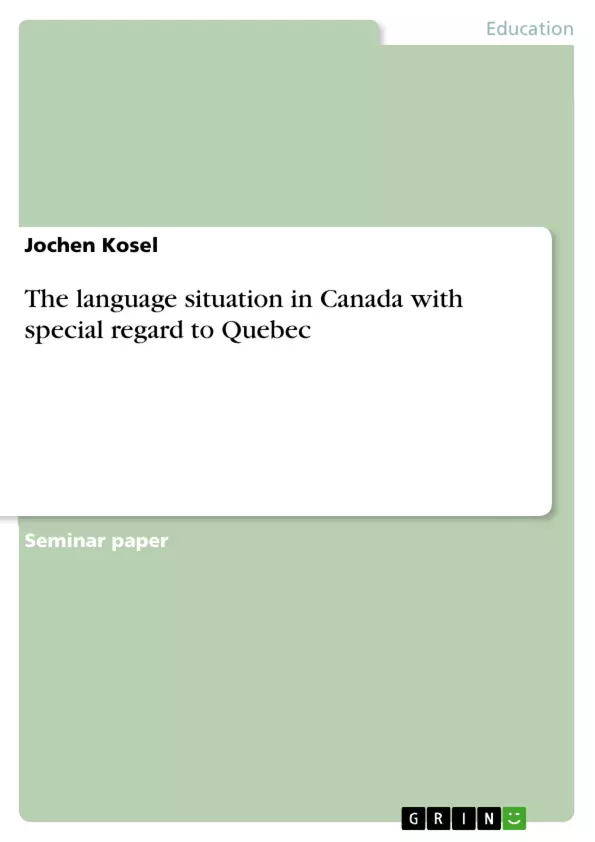Since its colonisation by Europeans the history of Canada has always been affected by the rivalry between two ethnic groups – the British and the French. This rivalry has slowly faded into a dualism which is still prominent in Canada. This dualism can be found in both Canada’s population and culture as well as in the fact that Canada has two official languages, French and English. This bilingualism of Canada will be the subject of this paper. I will not focus on the development of English in Canada in terms of a linguistic analysis though but will analyze the causes for this bilingualism instead. Furthermore I am going to analyze how both the federal government of Canada and the provincial government of Quebec – the only province that has a French speaking majority in the Canadian federation – have dealt with the existence of two major language groups.
In a first step I am going to give a general overview over Canada, including its geography, a brief look onto the composition of the Canadian population and the political system of Canada (2.1). The analysis of the political system is important to fully grasp the different levels of competency in Canada which will play a significant role in regard to legislation and jurisdiction of language laws in the Canadian federation and its provinces. Section 2.2 will deal with the history of Canada in relation to language contact. Starting with the early European colonisation (2.2.1) I am then going to analyze the period of British rule in Canada (2.2.2) before I am going to focus onto the time period starting with the foundation of the Dominion of Canada and Canada’s independence until today (2.2.3). Section 3 concentrates on the Canadian population in detail. While section 3.1 focuses on the Canadian population by ethnic origin, section 3.2 pays attention to the Canadian population by language. In section 4 I will analyze the official bilingualism in Canada, i.e. I will outline policies, constitutional provisions, and laws concerning bilingualism in Canada. Section 5 addresses the exceptional position of Quebec within the Canadian federation, especially with regard to its population and language legislation. In section 6 I will summarize my findings and will give an outlook on future language contact and language conflict in Canada.
Table of Contents
- Introduction
- Facts about Canada
- Geography, population and the political system of Canada
- The history of Canada in relation to language contact
- Early European colonisation
- British rule
- The Dominion of Canada and Canada's independence
- The Canadian population
- The Canadian population by ethnic origin
- The Canadian population by language
- Official bilingualism in Canada
- The exceptional position of Quebec
Objectives and Key Themes
This paper examines the language situation in Canada, with particular focus on the province of Quebec. It explores the historical and political factors that have shaped Canada's official bilingualism, examining the rivalry between English and French speaking communities. The paper also analyzes the unique position of Quebec within the Canadian federation and its impact on the national language landscape.
- The historical development of language contact and conflict in Canada
- The role of government policies and constitutional provisions in promoting and regulating bilingualism
- The impact of the French-speaking majority in Quebec on national language policy
- The dynamics of linguistic diversity and the relationship between English and French in Canada
- The challenges and opportunities for bilingualism in a multicultural society
Chapter Summaries
The introduction provides an overview of the paper's scope and methodology, highlighting the historical rivalry between British and French communities in Canada and its impact on the nation's bilingualism. The second chapter presents a detailed analysis of Canada's geography, population, and political system, demonstrating the foundation for the language contact between English and French speakers. It also outlines historical events that have shaped Canada's official bilingualism, including early European colonisation, British rule, and the establishment of the Dominion of Canada. Chapter three focuses on the Canadian population, examining its ethnic composition and language distribution. Chapter four investigates the official bilingualism policy in Canada, outlining relevant laws, constitutional provisions, and government initiatives. Finally, Chapter five explores the unique position of Quebec within the Canadian federation, considering its demographics, language legislation, and impact on the national language landscape.
Keywords
This paper focuses on the language situation in Canada, examining the historical development of language contact and conflict between English and French speakers, official bilingualism policy, and the exceptional position of Quebec within the Canadian federation. It analyzes the impact of these factors on the linguistic landscape of Canada and explores the relationship between English and French in a multicultural context. Key concepts include language contact, bilingualism, official language policy, linguistic diversity, and the unique circumstances of Quebec.
- Quote paper
- Jochen Kosel (Author), 2009, The language situation in Canada with special regard to Quebec, Munich, GRIN Verlag, https://www.grin.com/document/153635



